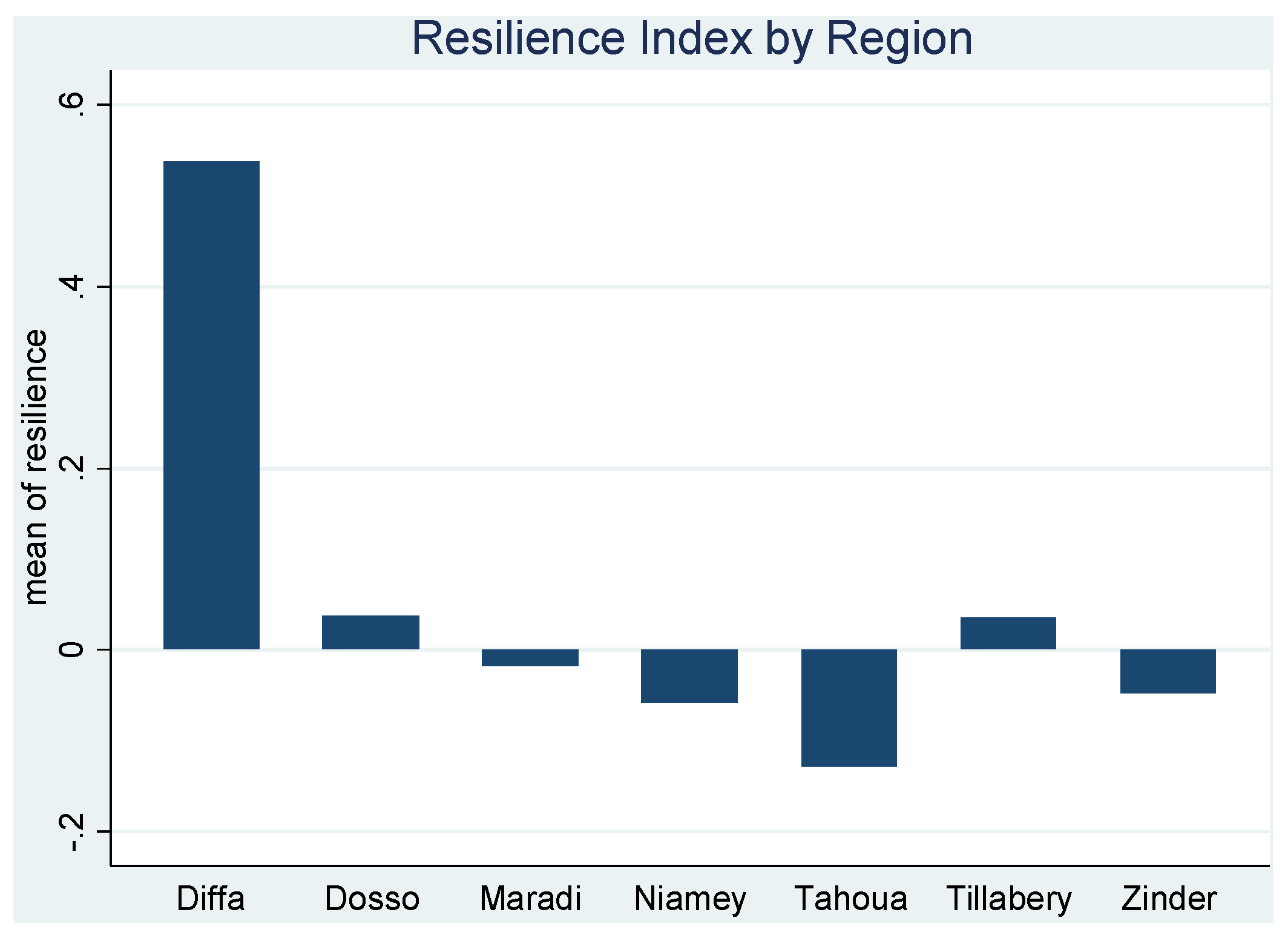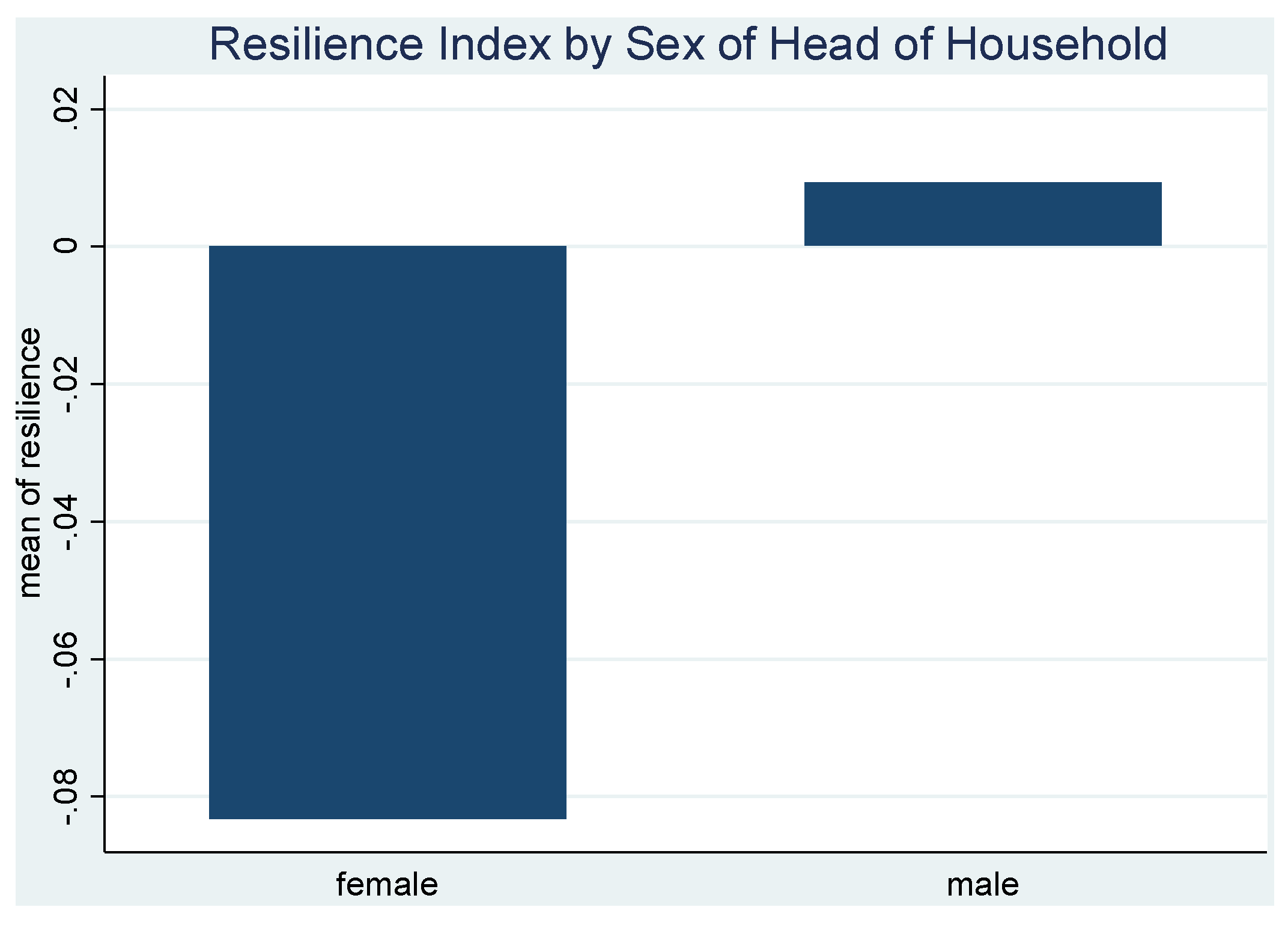Factors Affecting Rural Households’ Resilience to Food Insecurity in Niger
Abstract
:1. Introduction
- (1)
- Absorptive capacity: the ability to cope with and absorb the effects of shocks and stresses.
- (2)
- Adaptive capacity: the ability of individuals or societies to adjust and adapt to shocks and stresses, but keep the overall system functioning in quite the same manner.
- (3)
- Transformative capacity: the ability to change the system fundamentally when how it works is no longer viable.
2. Materials and Methods
2.1. Data Collection
2.2. Empirical Model
3. Results
3.1. Descriptive Statistics
3.2. Measuring Resilience
3.3. Determinants of Resilience
- (1)
- Root Mean Square Error of Approximation (RMSEA). It is a measure showing if the population approximately or closely fits the model. A RMSEA value less than 0.05 is considered to indicate a good fit. A RMSEA of 0.1 or more is often taken to indicate a poor fit. In our analysis, the RMSEA equals 0.03, meaning a reasonably good fit.
- (2)
- Standardized Root Mean Residual (SRMR). It is an index of how well our model fits. More precisely, it is a measure of how close we come to reproducing each correlation on average. Our SRMR of 0.03 means that, on average, we come within 0.03 of reproducing each correlation among the three latent indicators. The recommended value is less than 0.08 [29].
- (3)
- Comparative Fit Index (CFI). It is a widely used measure to examine how closely a model comes to fitting the data. It compares the model with a baseline model that assumes there is no relationship among the observed indicators variables. In other words, the CFI reported indicates that our model does 77.2% better than a null model in which we assume the items are all unrelated to each other.
4. Conclusions
Acknowledgments
Author Contributions
Conflicts of Interest
References
- Institut National de la Statistique (INS). Le Niger en Chiffres 2014. Available online: http://www.stat-niger.org/statistique/file/Affiches_Depliants/Nigerenchiffres2014def.pdf (accessed on 17 February 2016).
- Ericksen, P.J. What is the vulnerability of a food system to global environmental change? Ecol. Soc. 2008, 13, 14. [Google Scholar]
- Biasutti, M.; Giannini, A. Robust Sahel drying in response to late 20th century forcing. Geophys. Res. Lett. 2006. [Google Scholar] [CrossRef]
- Solomon, S. IPCC, 2007: Climate Change 2007: The Physical Science Basis. Contribution of Working Group I to the Fourth Assessment Report of the Intergovernmental Panel on Climate Change; Intergovernmental Panel on Climate Change (IPCC): New York, NY, USA, 2007. [Google Scholar]
- Food and Agriculture Organization of the United Nations (FAO). Rome Declaration on World Food Security and World Food Summit Plan of Action. In Proceeding of the World Food Summit Plan of Action, Rome, Italy, 13–17 November 1996.
- Wheeler, T.; von Braun, J. Climate Change Impacts on Global Food Security. Science 2013, 341, 508–513. [Google Scholar] [CrossRef] [PubMed]
- Pasteur, K. From Vulnerability to Resilience: A Framework for Analysis and Action to Build Community Resilience; Practical Action Publishing: Rugby, UK, 2011. [Google Scholar]
- Adger, N.W. Social and ecological resilience: Are they related? Progr. Hum. Geogr. 2000, 24, 347–364. [Google Scholar] [CrossRef]
- Alinovi, L.; Mane, E.; Romano, D. Measuring Household Resilience to Food Insecurity: Application to Palestinian Households; John Wiley & Sons, Ltd.: Chichester, UK, 2010. [Google Scholar]
- Béné, C.; Godfrey-Wood, R.; Newsham, A.; Davies, M. Resilience: New Utopia or New Tyranny? Reflection about the Potentials and Limits of the Concept of Resilience in Relation to Vulnerability Reduction Programmes; IDS Working Paper 405; Institute of Development Studies: Brighton, UK, 2012. [Google Scholar]
- Alinovi, L.; D’Errico, M.; Mane, E.; Romano, D. Livelihoods Strategies and Household Resilience to Food Insecurity: An Empirical Analysis to Kenya; Food and Agriculture Organization of the United Nations (FAO): Rome, Italy, 2010. [Google Scholar]
- Tefera, N.; Kayitakire, F. Household Resilience for Food and Nutrition Security: Empirical Evidence from Rural Household in Ethiopia. Available online: https://www.researchgate.net/publication/269872488_Household_Resilience_for_Food_and_Nutrition_Security_Empirical_Evidence_from_Rural_Household_in_Ethiopia (accessed on 17 February 2016).
- Ciani, F.; Romano, D. Testing for Household Resilience to Food Insecurity: Evidence from Nicaragua. Available online: http://ageconsearch.umn.edu/bitstream/182717/2/Romano-Testing_for_household_resilience_to_food_insecurity-380_a.pdf (accessed on 17 February 2016).
- Carter, M.R.; Little, P.D.; Mogues, T.; Negatu, W. Shocks, Sensitivity and Resilience: Tracking the Economic Impacts of Environmental Disaster on Assets in Ethiopia and Honduras; Development Strategy and Governance Division (DSGD) Discussion Paper, No. 32; International Food Policy Research Institute (IFPRI): Washington, DC, USA, 2006. [Google Scholar]
- Keil, A.; Zeller, M.; Wida, A.; Sanim, B.; Birner, R. What Determines Farmers’ Resilience towards ENSO Related Drought? An Empirical Assessment in Central Sulawesi, Indonesia. Climate Change 2008, 86, 291–307. [Google Scholar] [CrossRef]
- Lokosang, L.B.; Ramroop, S.; Zewotir, T. Indexing household resilience to food insecurity shocks: The case of South Sudan. Agrekon 2014, 53, 137–159. [Google Scholar] [CrossRef]
- Demeke, M.; Tefera, N. Sustainable Resilience for Food and Nutrition Security: The Case of Farming Rural Households in Ethiopia; Agricultural Development and Economics Division (ESA), Food and Agricultural Organization (FAO): Rome, Italy, 2013. [Google Scholar]
- Jolliffe, I.T. Principal Component Analysis, Second Edition; Springer Science + Business Media: Medford, MA, USA, 2002. [Google Scholar]
- Bollen, K.A. Structural Equations with Latent Variables; Wiley and Sons: New York, NY, USA, 1989. [Google Scholar]
- Intergovernmental Panel on Climate Change. Climate Change 2001: Impacts, Adaptation, and Vulnerability; IPCC: New York, NY, USA, 2001. [Google Scholar]
- Shah, K.; Dulal, H.; Johnson, C.; Baptiste, A. Understanding livelihood vulnerability to climate change: Applying the livelihood vulnerability index in Trinidad and Tobago. Geoforum 2013, 47, 125–137. [Google Scholar] [CrossRef]
- Haque, M.; Yamamoto, S.; Malik, A.; Sauerborn, R. Households’ perception of climate change and human health risks: A community perspective. Environ. Health 2012, 11, 1. [Google Scholar] [CrossRef] [PubMed]
- Kartiki, K. Climate change and migration: A case study from rural Bangladesh. Gender Dev. 2011, 19, 23–38. [Google Scholar] [CrossRef]
- Demetriades, J.; Esplen, E. The gender dimensions of poverty and climate change adaptation. IDS Bulletin 2008, 39, 24–31. [Google Scholar] [CrossRef] [Green Version]
- Below, T.; Mutabazi, K.; Kirschke, D.; Franke, C.; Sieber, S.; Siebert, R.; Tscherning, K. Can farmers’ adaptation to climate change be explained by socio-economic household-level variables? Glob. Environ. Change 2012, 22, 223–235. [Google Scholar] [CrossRef]
- Shah, K.U.; Dulal, H.B. Household capacity to adapt to climate change and implications for food security in Trinidad and Tobago. Reg. Environ. Change 2015, 15, 1379–1391. [Google Scholar] [CrossRef]
- Szabo, S.; Hossain, M.S.; Adger, W.N.; Matthews, Z.; Ahmed, S.; Lazar, A.N.; Ahmad, S. Soil Salinity, Household Wealth and Food Insecurity in Tropical Deltas: Evidence from South-West Coast of Bangladesh; Springer Japan: Tokyo, Japan, 2015. [Google Scholar]
- Dulal, H.; Shah, K.U. ‘Climate-Smart’ Social Protection: Can it be achieved without a targeted household approach? Environ. Dev. 2014, 10, 16–35. [Google Scholar] [CrossRef]
- Alan, C.A. Discovering Structural Equation Modeling Using Stata, Revised Edition; Stata Press: College Station, TX, USA, 2013. [Google Scholar]


| Variables | Unit of Measurement | Hypothesized Relationship with Resilience |
|---|---|---|
| Income | Amount of income earned by a household | The higher a household income is, the greater its level of resilience is supposed to be. |
| Food Expenditure | Amount of money spent on purchasing food | Spending more on food consumption is a sign of household’s wealth, even though in most rural areas buying food means lack of food production. |
| Farm | Number of farms exploited by the household during the rainy season. | Exploiting more farms may increase a household’s food availability or income that the activity may generate, thus increasing its resilience to food insecurity. |
| TLU | Livestock size in Tropical Livestock Units. | This is a materialized asset owned by a household and having more assets may increase a household’s resilience to uneven shock. |
| Stock | Duration of grain held in stock | The longer grain held in stock lasts, the greater a household’s adaptive capacity to food shortage is. |
| Shocks | Number of Households | Percent of Surveyed Households |
|---|---|---|
| Job loss | 244 | 2.67 |
| Income decrease | 3823 | 41.73 |
| Sickness/exceptional expenses | 4108 | 44.77 |
| Family member death | 1240 | 13.6 |
| Increase of food price | 4281 | 46.64 |
| Increase of fuel price/transport price | 283 | 3.1 |
| Increase of rent | 67 | 0.73 |
| Increase of agricultural inputs price | 909 | 9.96 |
| Power cut | 127 | 1.39 |
| Insecurity/robbery | 377 | 4.13 |
| Debt reimbursement | 1387 | 15.18 |
| Long-term unemployment | 317 | 3.48 |
| Natural hazards (floods, fire, winds...) | 1860 | 20.35 |
| Rainfall irregularity | 1226 | 13.44 |
| Assistance Programs | Number of Households | Percent of Household |
|---|---|---|
| Cereal bank | 2356 | 25.19 |
| Free distribution of food | 4659 | 49.81 |
| Grain sale at moderate price | 2869 | 30.67 |
| Food for work | 1118 | 11.95 |
| Cash for work | 1972 | 21.08 |
| Protection allowance | 1321 | 14.12 |
| Donation/zakat | 2187 | 23.38 |
| Blanket feeding | 1069 | 11.43 |
| Complementary allowance to pregnant and nursing women | 1271 | 13.59 |
| Agricultural inputs (fertilizers, seeds...) | 1024 | 10.95 |
| Cash transfers | 989 | 10.57 |
| Resilience Indicators | Unstandardized Estimates | Standardized Estimates | ||
|---|---|---|---|---|
| Coefficient | p-Value | Coefficient | p-Value | |
| Asset | 0.03 | 0.000 *** | 0.25 | 0.000 *** |
| Adaptive Capacity | −0.01 | 0.000 ** | −0.06 | 0.009 ** |
| Social Safety Nets | 0.01 | 0.005 *** | 0.05 | 0.004 ** |
| Climate Change (CC) | −5.86 | 0.005 ** | −0.03 | 0.005 ** |
| Constant | 441.04 | 0.000 *** | 3.01 | 0.000 *** |
| Resilience Indicators | Male | Female | ||
|---|---|---|---|---|
| Standardized Estimates | Standardized Estimates | |||
| Coefficient | p-Value | Coefficient | p-Value | |
| Asset (A) | 0.25 | 0.000 *** | 0.37 | 0.000 *** |
| Adaptive Capacity (AC) | −0.06 | 0.010 ** | −0.06 | 0.256 |
| Social safety Nets (SSN) | 0.05 | 0.006 ** | 0.04 | 0.474 |
| Climate Change (CC) | −0.03 | 0.002 ** | −0.02 | 0.003 ** |
| Constant | 3.02 | 0.000 *** | 2.89 | 0.000 *** |
© 2016 by the authors; licensee MDPI, Basel, Switzerland. This article is an open access article distributed under the terms and conditions of the Creative Commons by Attribution (CC-BY) license (http://creativecommons.org/licenses/by/4.0/).
Share and Cite
Gambo Boukary, A.; Diaw, A.; Wünscher, T. Factors Affecting Rural Households’ Resilience to Food Insecurity in Niger. Sustainability 2016, 8, 181. https://doi.org/10.3390/su8030181
Gambo Boukary A, Diaw A, Wünscher T. Factors Affecting Rural Households’ Resilience to Food Insecurity in Niger. Sustainability. 2016; 8(3):181. https://doi.org/10.3390/su8030181
Chicago/Turabian StyleGambo Boukary, Aboubakr, Adama Diaw, and Tobias Wünscher. 2016. "Factors Affecting Rural Households’ Resilience to Food Insecurity in Niger" Sustainability 8, no. 3: 181. https://doi.org/10.3390/su8030181






